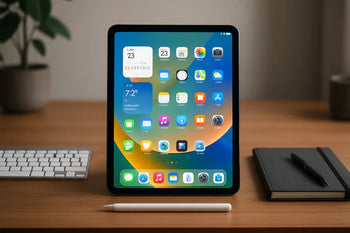Assistive Touch on iPad is a built‑in feature that makes navigation easier and helps protect your iPad’s hardware buttons. Instead of pressing physical buttons, you can use a floating on‑screen menu for quick actions.
It’s especially helpful if your iPad’s buttons are hard to reach, not working properly, or you just want faster shortcuts. With Assistive Touch, you can take screenshots, adjust volume, or lock the screen with a simple tap.
This guide explains what Assistive Touch is, how to enable it, and the best ways to customize it for everyday use.
Make everyday navigation even easier with a built‑in stand. Explore our flip iPad cases for hands‑free comfort while using Assistive Touch.
What Is Assistive Touch On iPad?

AssistiveTouch adds a small on-screen button to your iPad. It lets you handle actions that usually require pressing physical buttons or using tricky gestures, making your device easier to manage.
A Virtual Button For Easier Control
When you enable AssistiveTouch, a virtual button pops up on your display. You can move it along any edge so it doesn’t get in your way.
Tapping the button opens a menu filled with shortcuts. These can replace the home button, volume controls, or gestures like pinch and swipe.
If you connect an external device like a Bluetooth mouse or trackpad, you can control the pointer through AssistiveTouch. That’s a plus if you’d rather not rely on touch input alone.
The menu is yours to customize. Maybe you want quick access to screenshots, locking the screen, or opening Control Center—just add those actions.
Why Assistive Touch Is Useful
AssistiveTouch really helps if you have trouble pressing buttons or doing multi-finger gestures. It cuts down on strain by letting you do the same tasks with just a tap.
If your home or side buttons stop working, you can use the on-screen button for power, volume, and navigation. That way, you don’t have to rush to get your device fixed.
People using adaptive accessories benefit too. Pair AssistiveTouch with external input devices and control your iPad in whatever way works best for you.
Since you can tailor the menu to your own habits, it saves time and makes everyday use smoother.
Everyday Tasks Made Simpler
With AssistiveTouch, you can tackle lots of daily tasks without the hardware buttons. For example, you can:
- Take screenshots with a single tap
- Adjust volume without pressing side buttons
- Restart or lock the screen from the menu
- Access Siri through the AssistiveTouch button
You can also make custom gestures. Let’s say a two-finger pinch is tricky for you—you can record it once and then use it with just a tap.
Navigation gets smoother, and you don’t need as much finger precision. Whether you’re after convenience or need it for accessibility, AssistiveTouch gives you more control over your iPad.
Want both style and protection while making the most of AssistiveTouch? Explore our leather iPad cases designed for durability and a premium feel.
How To Enable And Customize Assistive Touch
You can turn on AssistiveTouch from your iPad’s settings, add it to Control Center for quick access, and adjust the menu and gestures to fit your routine. Each step puts you more in charge of how you use your device.
Turning On Assistive Touch In Settings
Open the Settings app and head to Accessibility. In the Touch section, tap AssistiveTouch and flip the switch to turn it on.
Once it’s enabled, a floating button appears on your screen. Move it anywhere along the edges for convenience.
If you prefer voice commands, ask Siri to “Turn on AssistiveTouch.” Or, set up an Accessibility Shortcut so a triple-click of the top button toggles it on or off. That way, you only use it when you need it.
Adding Assistive Touch To Control Center
For faster access, add AssistiveTouch to Control Center. Go to Settings > Control Center and tap Customize Controls. Add Accessibility Shortcuts from the list.
Now, swipe down from the top-right corner and you’ll see the shortcut in Control Center. Tapping it turns AssistiveTouch on or off right away.
This keeps your display clear if you don’t want the floating button visible all the time. It also saves you from digging through Settings whenever you want to use it.
Customizing Menus, Gestures, And Shortcuts
Change the top-level menu in AssistiveTouch to include your most-used tools. Tap Customize Top Level Menu in the settings to add, remove, or rearrange icons like Home, Lock Screen, Screenshot, or Volume.
Create custom gestures if you need them. Maybe a three-finger swipe is tough—record it once and use it with a tap. You can also save multi-finger gestures like pinch or zoom for quick access.
Assign different functions to single-tap, double-tap, or long-press on the AssistiveTouch button under Custom Actions. That way, things like opening Control Center or going home get faster.
With these options, you can shape AssistiveTouch to fit your daily habits, whether you want to simplify gestures or replace hardware buttons.
How To Use Assistive Touch Effectively

AssistiveTouch puts important functions just a tap away, no physical buttons needed. You can return home, adjust volume, snap screenshots, and lock your screen using the floating menu.
Navigating Home, Siri, And Volume Controls
The AssistiveTouch menu includes shortcuts that take the place of the Home button. Tapping Home brings you right back to the main screen, which is handy if your device doesn’t have a physical button.
You can access Siri from the menu, too. It works like holding down the top or side button, but it’s just a quick tap.
For sound, use the Volume Up and Volume Down options. That way, you can change the volume without touching the hardware buttons—helpful if those buttons are stubborn or broken.
Feel free to rearrange the menu so your favorite controls are always easy to reach.
Taking Screenshots And Locking The Screen
AssistiveTouch lets you take screenshots without pressing multiple buttons. Tap Device > More > Screenshot, and the image saves right to your Photos app.
You can lock your screen with AssistiveTouch, too. Just tap Device > Lock Screen to put your iPad to sleep—no need to strain your hands or wear out the button.
If you want even quicker access, assign Screenshot or Lock Screen to a custom gesture or the top-level menu. That way, you’re just a tap or two away when you need it.
Troubleshooting Common Issues
If AssistiveTouch doesn’t show up after you enable it, double-check the toggle in Settings > Accessibility > Touch > AssistiveTouch. Restarting your iPad sometimes clears up glitches.
If the menu feels slow, try removing a few shortcuts from the top-level menu. Fewer items can make it run more smoothly.
If the floating button gets in your way, drag it to another edge. You can also lower the Idle Opacity so the button fades when you’re not using it.
For issues with screenshots or the lock screen, make sure the shortcut is in your menu. Re-adding it often gets things working again.
Prefer a lightweight option that doesn’t add bulk? Discover our thin iPad cases for sleek protection that keeps your iPad easy to handle.
Conclusion: Getting the Most from Assistive Touch on iPad
Assistive Touch on iPad is more than just an accessibility tool—it’s a convenient way to navigate your device, protect the hardware buttons, and speed up everyday tasks. By enabling and customizing it, you can make your iPad easier to use whether you rely on shortcuts, gestures, or quick access to essential features.
A few minutes of setup goes a long way in improving comfort and efficiency. With the right habits and accessories, your iPad can stay reliable and user‑friendly for years to come.
For more ways to maximize your iPad, read our guide on can I use my iPad to make phone calls without iPhone.
Frequently Asked Questions
You can manage AssistiveTouch right from your iPad settings. Enable, disable, or adjust it if the button isn’t showing up. You can also use it to reach features like Control Center without swiping.
How do I turn on Assistive Touch on my iPad?
Go to Settings > Accessibility > Touch > AssistiveTouch. Switch it on, and a floating button will appear on your screen. You can move this button anywhere for quick access.
How do I turn off my iPad Assistive Touch?
Open Settings > Accessibility > Touch > AssistiveTouch. Toggle the switch off to remove the floating button. The feature can be turned back on anytime.
Why is Assistive Touch not appearing?
Check if Assistive Touch is enabled in Settings. If it’s on but missing, restart your iPad. Updating iPadOS can also fix glitches that hide the button.
How to access Control Center on iPad without swiping?
Tap the Assistive Touch button on your screen. Choose Control Center from the menu. It will open instantly without swiping.



















